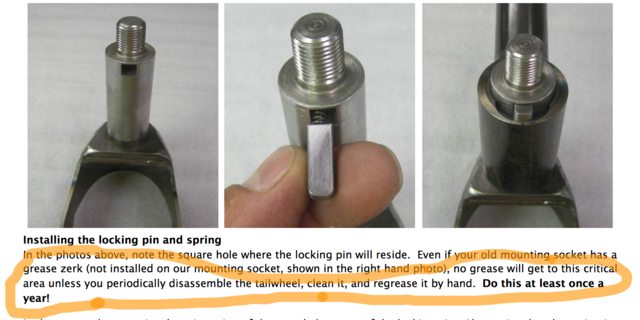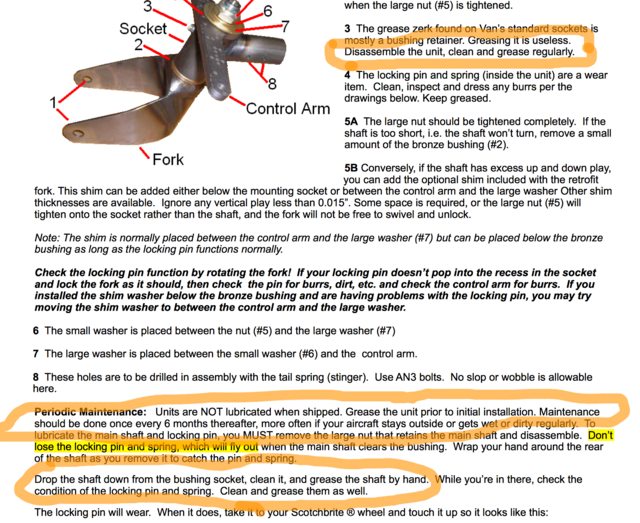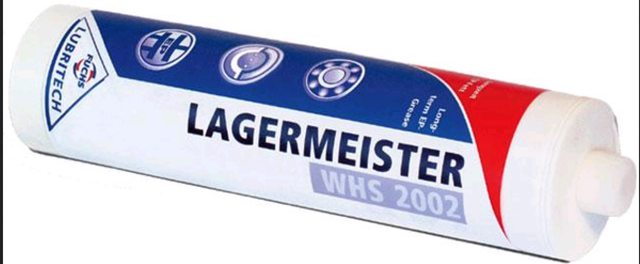After seeing that another RV-8 ran off a runway last week I thought I’d share my experience with my own directional control on rollout issues.
I finished my RV-8 in 2014. It had a Bell tailwheel fork and a single steering arm on it. It looked dandy! I liked the way it handled while taxiing and I was happy. It wasn’t very long after my first flight that I noticed controllability during the landing rollout was not as good as I would have liked. I never left the runway or scratched anything but came way too close on more than one occasion. Sometimes the rollout was straight as an arrow, but the excitement started as soon as the SLIGHTEST correction was made to chance direction. Wind speed or direction did not matter. My RV grin turned to an RV grimace right before touchdown.
I talked to local experts and any RV guys I found at OSH, phoned distant experts and poured through VAF archives. I checked toe in/out several times and it was fine. I was SURE I must be dragging a brake since sometimes it would be turning opposite the rudder input. Usually turning right while applying full left rudder AND brake. I found Randy Leverold’s rudder pedal extension plans and modified my pedals. Initially I thought I had the problem solved but it was only about a dozen landings or so before the same symptoms popped up.
My attention turned to the tailwheel again. I propped the tail up on a saw horse, checked the adjustment again, checked the locking pin operation again and checked for freedom of movement again. I went back to VAF and read about what a docile pussy cat the RV-8 was to land. I could 3 point or wheel land on either or both mains with no problem, but just couldn’t seem to keep it going straight. Either my issue was unique, or everyone just figures it’s a problem with the pilot and they’re embarrassed to say anything. While the thought of selling it and buying a 150 flashed through my head, I got the idea to lift the tail by the bottom of the wheel. I interlaced my fingers and lifted the tailwheel while turning it left and right at the same time. The more weight I put on it, the harder it was to turn. By the time I had the tail totally lifted up I could barely turn it. Light bulb time! I greased it up really good and flew it again. It was magnificent! But in only 5 to 10 landings it started to get stiff again. I looked back and found there were 30 landings on the grease job prior to discovering the binding. I disassembled the tailwheel assembly and looked for burrs, or anything amiss and found nothing. I put a grease zerk in the tailwheel yoke and polished everything in there really well. I’d give it a little pump of grease every other time I went flying and flew it until the next winter.
My fix was to buy a tailwheel yoke with the ball bearing from JDair, keep my Bell fork, install the stock springs and make custom steering cables attached to new attach points on the rudder (copied from Dan Horton). Another thing I learned was that full rudder deflection should not unlock the tailwheel. I couldn’t achieve that without machining out a little of the key slot in the top of the yoke if I kept my single steering arm.
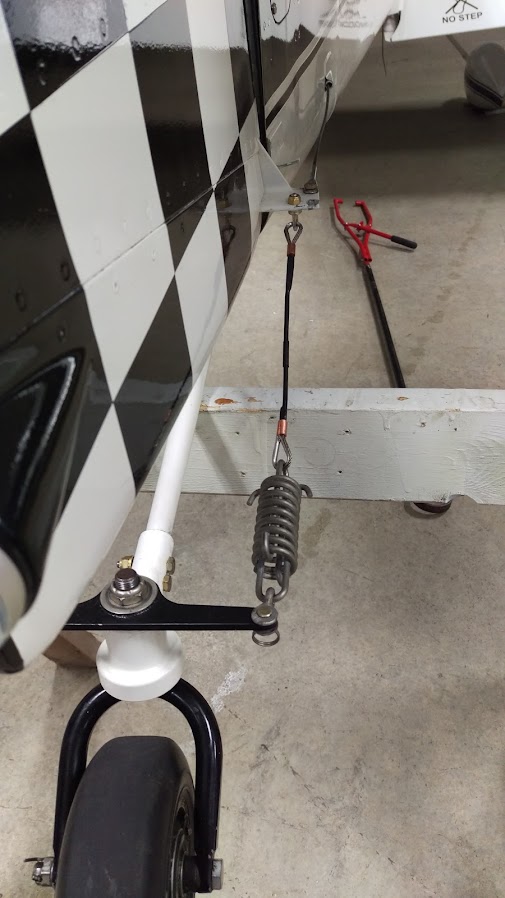
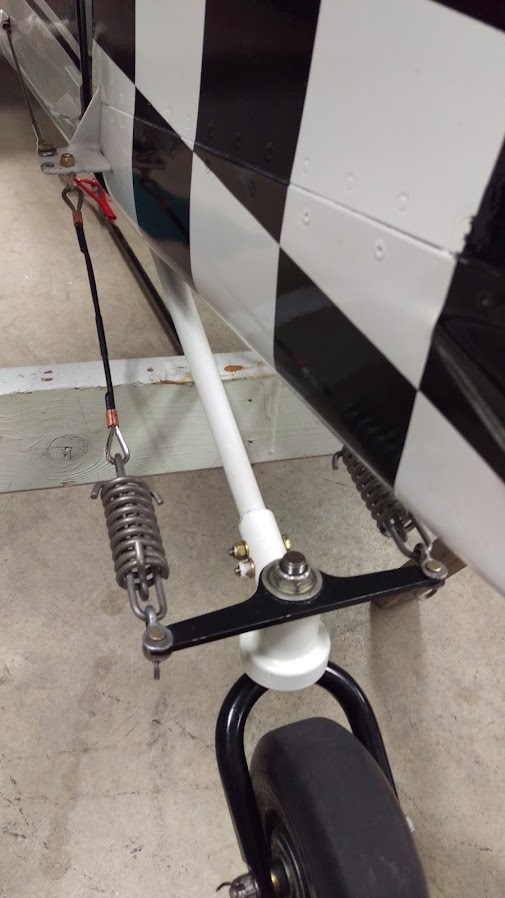
With 10,000 RVs flying and a bunch of them tail draggers I don’t think there’s anything wrong with the Van’s yoke, but the combination of MY stock yoke, and MY Bell fork and (maybe) MY steering link did not allow ME to steer.
I have been flying with this tailwheel set up for almost two years and it has transformed my tasmanian devil into the pussy cat I read about.
The lack of complaints about this prompted me to write about my experience. Maybe it’s unique, maybe not, but if it saves just one RV I’ll be happy.
I am curious if this has caused any loss of control accidents? You’ll never know unless you lift and turn.
I finished my RV-8 in 2014. It had a Bell tailwheel fork and a single steering arm on it. It looked dandy! I liked the way it handled while taxiing and I was happy. It wasn’t very long after my first flight that I noticed controllability during the landing rollout was not as good as I would have liked. I never left the runway or scratched anything but came way too close on more than one occasion. Sometimes the rollout was straight as an arrow, but the excitement started as soon as the SLIGHTEST correction was made to chance direction. Wind speed or direction did not matter. My RV grin turned to an RV grimace right before touchdown.
I talked to local experts and any RV guys I found at OSH, phoned distant experts and poured through VAF archives. I checked toe in/out several times and it was fine. I was SURE I must be dragging a brake since sometimes it would be turning opposite the rudder input. Usually turning right while applying full left rudder AND brake. I found Randy Leverold’s rudder pedal extension plans and modified my pedals. Initially I thought I had the problem solved but it was only about a dozen landings or so before the same symptoms popped up.
My attention turned to the tailwheel again. I propped the tail up on a saw horse, checked the adjustment again, checked the locking pin operation again and checked for freedom of movement again. I went back to VAF and read about what a docile pussy cat the RV-8 was to land. I could 3 point or wheel land on either or both mains with no problem, but just couldn’t seem to keep it going straight. Either my issue was unique, or everyone just figures it’s a problem with the pilot and they’re embarrassed to say anything. While the thought of selling it and buying a 150 flashed through my head, I got the idea to lift the tail by the bottom of the wheel. I interlaced my fingers and lifted the tailwheel while turning it left and right at the same time. The more weight I put on it, the harder it was to turn. By the time I had the tail totally lifted up I could barely turn it. Light bulb time! I greased it up really good and flew it again. It was magnificent! But in only 5 to 10 landings it started to get stiff again. I looked back and found there were 30 landings on the grease job prior to discovering the binding. I disassembled the tailwheel assembly and looked for burrs, or anything amiss and found nothing. I put a grease zerk in the tailwheel yoke and polished everything in there really well. I’d give it a little pump of grease every other time I went flying and flew it until the next winter.
My fix was to buy a tailwheel yoke with the ball bearing from JDair, keep my Bell fork, install the stock springs and make custom steering cables attached to new attach points on the rudder (copied from Dan Horton). Another thing I learned was that full rudder deflection should not unlock the tailwheel. I couldn’t achieve that without machining out a little of the key slot in the top of the yoke if I kept my single steering arm.
With 10,000 RVs flying and a bunch of them tail draggers I don’t think there’s anything wrong with the Van’s yoke, but the combination of MY stock yoke, and MY Bell fork and (maybe) MY steering link did not allow ME to steer.
I have been flying with this tailwheel set up for almost two years and it has transformed my tasmanian devil into the pussy cat I read about.
The lack of complaints about this prompted me to write about my experience. Maybe it’s unique, maybe not, but if it saves just one RV I’ll be happy.
I am curious if this has caused any loss of control accidents? You’ll never know unless you lift and turn.
Last edited:



